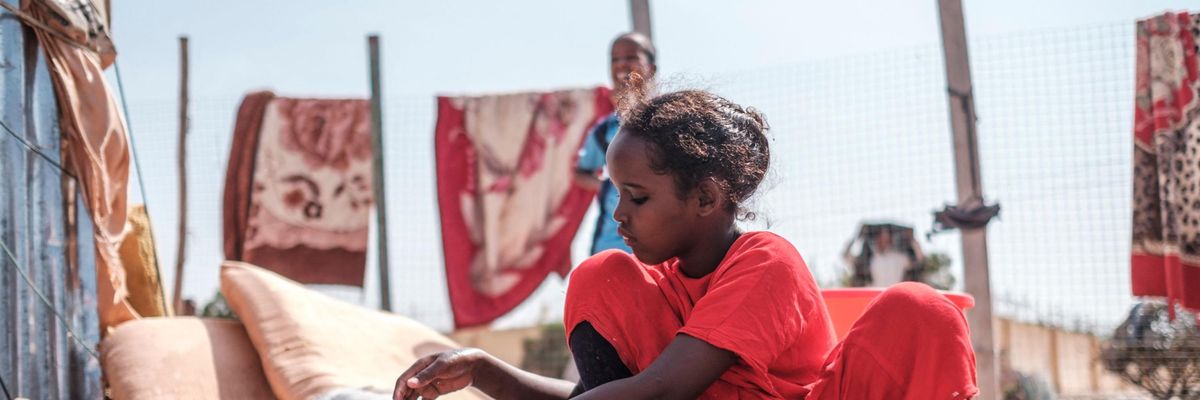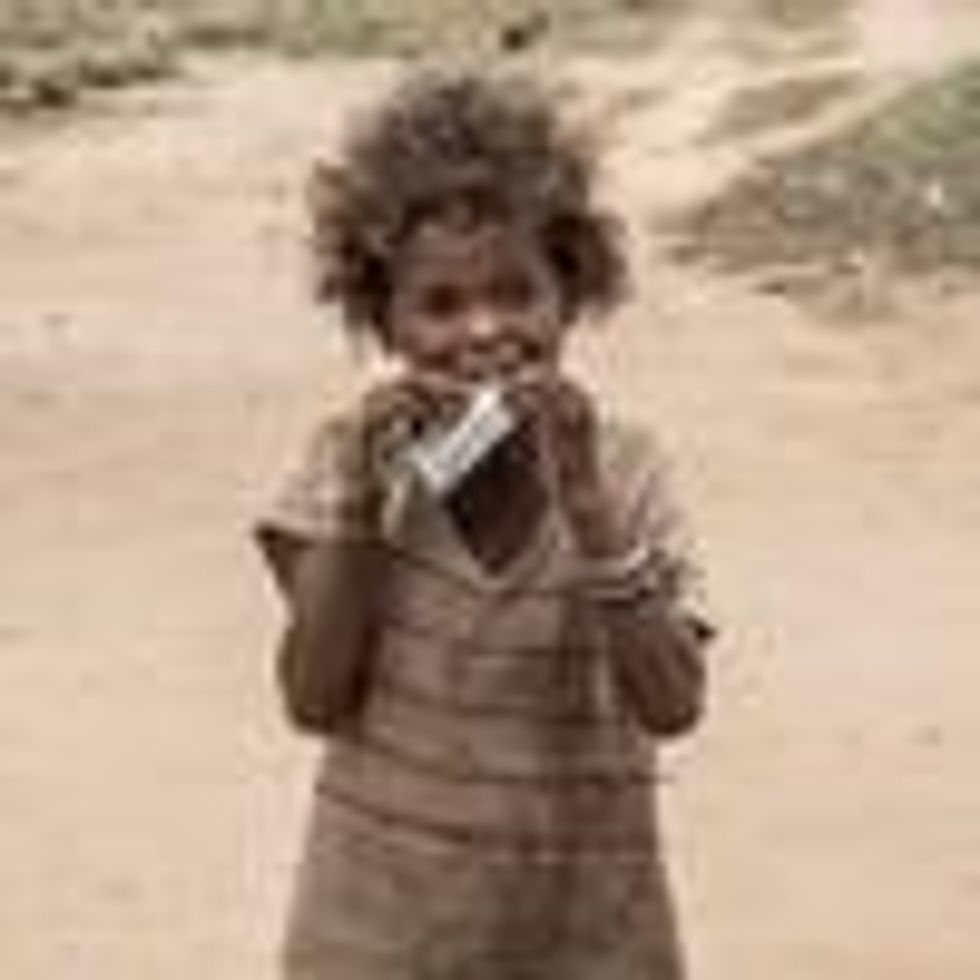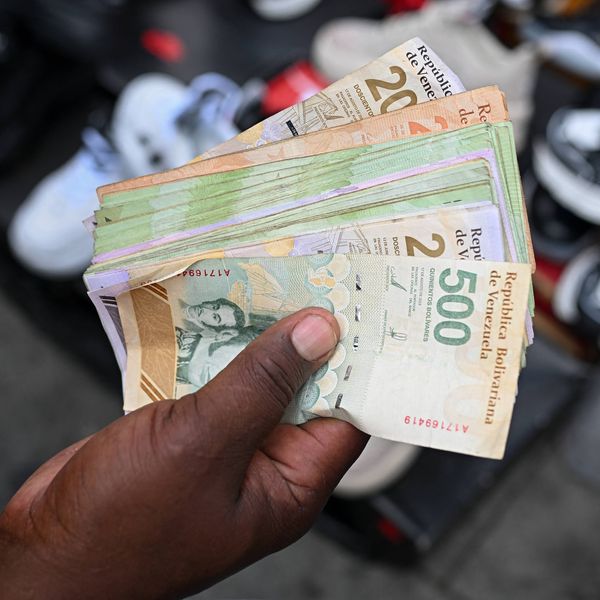
A child washes dishes at an informal settlement of internally displaced people in the outskirts of the city of Hargeisa, Somaliland, on September 16, 2021. In recent years, climate-fueled disasters including drought--not conflict--have been the main driver of displacement in Somalia, a war-torn nation in the Horn of Africa that ranks among the world's most vulnerable to climate change. (Photo: Eduardo Soteras/AFP via Getty Images)
Climate-Fueled Drought Pushing Millions 'to the Brink' in War-Torn Somalia
"You can run away from the fighting," said one local leader in central Somalia, "but you can't escape from the drought."
Several consecutive failed rainy seasons have left 3.5 million people in Somalia facing extreme hunger, leading experts to warn that the war-torn country in the Horn of Africa is already experiencing the deadly effects of the climate emergency and is in dire need of mitigation interventions as well as humanitarian aid.
"Some have already experienced intense drought for more than a year and have had to watch their livestock, crops, and savings perish in front of their eyes."
The drought, in which the last three rainy seasons have failed to sustain crops, livestock, and drinking water sources, has left almost the entire country--90%--facing severe water shortages, forcing thousands of people from their homes as they search the country for food and water and pushing the federal government to declare a state of emergency in November.
"Some have already experienced intense drought for more than a year and have had to watch their livestock, crops, and savings perish in front of their eyes," said Amjad Ali, country director for Somalia at Oxfam, in a statement Monday. "They urgently need lifesaving water, food, and cash."
The 2021 heavy rain season in southern Somalia yielded 48,900 tons of cereal grains, according to the Integrated Food Security Phase Classification--60% below the average between 1995 and 2020.
"Urgent support and climate adaptation interventions are needed," said Adam Abdelmoula, United Nations resident coordinator in Somalia.
\u201cThe woman on my right lost 200 goats, 2 camels and a donkey to the #drought. She & her children are now sheltering under a tree in #Garbagaarey. There are many like her across #Somalia\u2019s hardest hit regions. Urgent support & #climate adaptation interventions are needed.\u201d— Adam Abdelmoula (@Adam Abdelmoula) 1638962936
Somalia's drought--a weather pattern that scientists say the human-driven climate crisis has contributed to--has had a domino effect in the country, harming families' financial wellbeing as water sources dry up and the price of potable water goes up.
The cost of a 200-liter water drum has gone up from the five-year average by 45% to more than 170% in parts of the country, according to Oxfam.
"We did not receive rain for two seasons," a farmer named Maryan Abdulaahi told Oxfam. "Our livestock and own lives are in danger. In Dudumaale we used to fetch water from berkeds [traditional Somali water cisterns], but all berkeds are empty right now. The drum of water costs $4 which we cannot afford."
The nongovernmental organization WASDA, which works with pastoral communities, said a climate crisis-fueled famine like the one more than one million people in Madagascar are facing could be "imminent."
Related Content

'Unprecedented': Madagascar on Verge of World's First Climate-Fueled Famine
"I have been involved in droughts since 1991 and I have never seen a drought that has impacted people as badly as has this one," executive director Aydrus Daar told Oxfam. "Many pastoralists have lost 100% of their livestock. This has never occurred in living history."
Somalian news outlet Garowe reported Tuesday that the severe drought has already been linked to the deaths of six people in Galmudug state in central Somalia.
\u201cReports from central #Somalia indicate that six people died of starvation and thirst due to the severe drought in Mudug and Galgadud regions of Galmudug state say a regional official.\n\nDrought conditions are spreading throughout the country amid security and election challenges.\u201d— GAROWE ONLINE (@GAROWE ONLINE) 1639492974
The crisis has been compounded by ongoing conflict, with heavy fighting in parts of the country between the Somali National Army and the Ahlu Sunnah Wal Jama'a group--driving people across the country "to the brink," the International Committee of the Red Cross said Tuesday.
"Many pastoralists have lost 100% of their livestock. This has never occurred in living history."
Though nearly 133,000 people have been internally displaced by the drought conditions and have moved toward urban areas in hopes of accessing water, there are few places to find respite from the crisis.
Oxfam estimates that 7.7 million people--nearly half the country's population--will be in need of humanitarian assistance in 2022, a 30% rise from this year.
"You can run away from the fighting," Deeko Adan Warsame, a leader in the town of Guriel in Galmudug state, told Al Jazeera last week, "but you can't escape from the drought."
An Urgent Message From Our Co-Founder
Dear Common Dreams reader, The U.S. is on a fast track to authoritarianism like nothing I've ever seen. Meanwhile, corporate news outlets are utterly capitulating to Trump, twisting their coverage to avoid drawing his ire while lining up to stuff cash in his pockets. That's why I believe that Common Dreams is doing the best and most consequential reporting that we've ever done. Our small but mighty team is a progressive reporting powerhouse, covering the news every day that the corporate media never will. Our mission has always been simple: To inform. To inspire. And to ignite change for the common good. Now here's the key piece that I want all our readers to understand: None of this would be possible without your financial support. That's not just some fundraising cliche. It's the absolute and literal truth. We don't accept corporate advertising and never will. We don't have a paywall because we don't think people should be blocked from critical news based on their ability to pay. Everything we do is funded by the donations of readers like you. Will you donate now to help power the nonprofit, independent reporting of Common Dreams? Thank you for being a vital member of our community. Together, we can keep independent journalism alive when it’s needed most. - Craig Brown, Co-founder |
Several consecutive failed rainy seasons have left 3.5 million people in Somalia facing extreme hunger, leading experts to warn that the war-torn country in the Horn of Africa is already experiencing the deadly effects of the climate emergency and is in dire need of mitigation interventions as well as humanitarian aid.
"Some have already experienced intense drought for more than a year and have had to watch their livestock, crops, and savings perish in front of their eyes."
The drought, in which the last three rainy seasons have failed to sustain crops, livestock, and drinking water sources, has left almost the entire country--90%--facing severe water shortages, forcing thousands of people from their homes as they search the country for food and water and pushing the federal government to declare a state of emergency in November.
"Some have already experienced intense drought for more than a year and have had to watch their livestock, crops, and savings perish in front of their eyes," said Amjad Ali, country director for Somalia at Oxfam, in a statement Monday. "They urgently need lifesaving water, food, and cash."
The 2021 heavy rain season in southern Somalia yielded 48,900 tons of cereal grains, according to the Integrated Food Security Phase Classification--60% below the average between 1995 and 2020.
"Urgent support and climate adaptation interventions are needed," said Adam Abdelmoula, United Nations resident coordinator in Somalia.
\u201cThe woman on my right lost 200 goats, 2 camels and a donkey to the #drought. She & her children are now sheltering under a tree in #Garbagaarey. There are many like her across #Somalia\u2019s hardest hit regions. Urgent support & #climate adaptation interventions are needed.\u201d— Adam Abdelmoula (@Adam Abdelmoula) 1638962936
Somalia's drought--a weather pattern that scientists say the human-driven climate crisis has contributed to--has had a domino effect in the country, harming families' financial wellbeing as water sources dry up and the price of potable water goes up.
The cost of a 200-liter water drum has gone up from the five-year average by 45% to more than 170% in parts of the country, according to Oxfam.
"We did not receive rain for two seasons," a farmer named Maryan Abdulaahi told Oxfam. "Our livestock and own lives are in danger. In Dudumaale we used to fetch water from berkeds [traditional Somali water cisterns], but all berkeds are empty right now. The drum of water costs $4 which we cannot afford."
The nongovernmental organization WASDA, which works with pastoral communities, said a climate crisis-fueled famine like the one more than one million people in Madagascar are facing could be "imminent."
Related Content

'Unprecedented': Madagascar on Verge of World's First Climate-Fueled Famine
"I have been involved in droughts since 1991 and I have never seen a drought that has impacted people as badly as has this one," executive director Aydrus Daar told Oxfam. "Many pastoralists have lost 100% of their livestock. This has never occurred in living history."
Somalian news outlet Garowe reported Tuesday that the severe drought has already been linked to the deaths of six people in Galmudug state in central Somalia.
\u201cReports from central #Somalia indicate that six people died of starvation and thirst due to the severe drought in Mudug and Galgadud regions of Galmudug state say a regional official.\n\nDrought conditions are spreading throughout the country amid security and election challenges.\u201d— GAROWE ONLINE (@GAROWE ONLINE) 1639492974
The crisis has been compounded by ongoing conflict, with heavy fighting in parts of the country between the Somali National Army and the Ahlu Sunnah Wal Jama'a group--driving people across the country "to the brink," the International Committee of the Red Cross said Tuesday.
"Many pastoralists have lost 100% of their livestock. This has never occurred in living history."
Though nearly 133,000 people have been internally displaced by the drought conditions and have moved toward urban areas in hopes of accessing water, there are few places to find respite from the crisis.
Oxfam estimates that 7.7 million people--nearly half the country's population--will be in need of humanitarian assistance in 2022, a 30% rise from this year.
"You can run away from the fighting," Deeko Adan Warsame, a leader in the town of Guriel in Galmudug state, told Al Jazeera last week, "but you can't escape from the drought."
Several consecutive failed rainy seasons have left 3.5 million people in Somalia facing extreme hunger, leading experts to warn that the war-torn country in the Horn of Africa is already experiencing the deadly effects of the climate emergency and is in dire need of mitigation interventions as well as humanitarian aid.
"Some have already experienced intense drought for more than a year and have had to watch their livestock, crops, and savings perish in front of their eyes."
The drought, in which the last three rainy seasons have failed to sustain crops, livestock, and drinking water sources, has left almost the entire country--90%--facing severe water shortages, forcing thousands of people from their homes as they search the country for food and water and pushing the federal government to declare a state of emergency in November.
"Some have already experienced intense drought for more than a year and have had to watch their livestock, crops, and savings perish in front of their eyes," said Amjad Ali, country director for Somalia at Oxfam, in a statement Monday. "They urgently need lifesaving water, food, and cash."
The 2021 heavy rain season in southern Somalia yielded 48,900 tons of cereal grains, according to the Integrated Food Security Phase Classification--60% below the average between 1995 and 2020.
"Urgent support and climate adaptation interventions are needed," said Adam Abdelmoula, United Nations resident coordinator in Somalia.
\u201cThe woman on my right lost 200 goats, 2 camels and a donkey to the #drought. She & her children are now sheltering under a tree in #Garbagaarey. There are many like her across #Somalia\u2019s hardest hit regions. Urgent support & #climate adaptation interventions are needed.\u201d— Adam Abdelmoula (@Adam Abdelmoula) 1638962936
Somalia's drought--a weather pattern that scientists say the human-driven climate crisis has contributed to--has had a domino effect in the country, harming families' financial wellbeing as water sources dry up and the price of potable water goes up.
The cost of a 200-liter water drum has gone up from the five-year average by 45% to more than 170% in parts of the country, according to Oxfam.
"We did not receive rain for two seasons," a farmer named Maryan Abdulaahi told Oxfam. "Our livestock and own lives are in danger. In Dudumaale we used to fetch water from berkeds [traditional Somali water cisterns], but all berkeds are empty right now. The drum of water costs $4 which we cannot afford."
The nongovernmental organization WASDA, which works with pastoral communities, said a climate crisis-fueled famine like the one more than one million people in Madagascar are facing could be "imminent."
Related Content

'Unprecedented': Madagascar on Verge of World's First Climate-Fueled Famine
"I have been involved in droughts since 1991 and I have never seen a drought that has impacted people as badly as has this one," executive director Aydrus Daar told Oxfam. "Many pastoralists have lost 100% of their livestock. This has never occurred in living history."
Somalian news outlet Garowe reported Tuesday that the severe drought has already been linked to the deaths of six people in Galmudug state in central Somalia.
\u201cReports from central #Somalia indicate that six people died of starvation and thirst due to the severe drought in Mudug and Galgadud regions of Galmudug state say a regional official.\n\nDrought conditions are spreading throughout the country amid security and election challenges.\u201d— GAROWE ONLINE (@GAROWE ONLINE) 1639492974
The crisis has been compounded by ongoing conflict, with heavy fighting in parts of the country between the Somali National Army and the Ahlu Sunnah Wal Jama'a group--driving people across the country "to the brink," the International Committee of the Red Cross said Tuesday.
"Many pastoralists have lost 100% of their livestock. This has never occurred in living history."
Though nearly 133,000 people have been internally displaced by the drought conditions and have moved toward urban areas in hopes of accessing water, there are few places to find respite from the crisis.
Oxfam estimates that 7.7 million people--nearly half the country's population--will be in need of humanitarian assistance in 2022, a 30% rise from this year.
"You can run away from the fighting," Deeko Adan Warsame, a leader in the town of Guriel in Galmudug state, told Al Jazeera last week, "but you can't escape from the drought."

